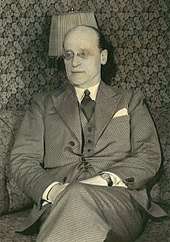Carl Marstrander
Carl Johan Sverdrup Marstrander (26 November 1883 – 23 December 1965) was a Norwegian linguist, known for his work on the Irish language.[1] His works, largely written in Norwegian, on the Celtic and Norse components in Norwegian culture, are considered important for modern Norway.[2]

Life
He was a student of Sophus Bugge and Alf Torp, and spent time in Ireland from 1907, studying modern Irish on Great Blasket Island with Tomás Ó Criomhthain,[3][4] and then teaching at the School of Irish Learning in 1910. He jointly edited Ériu volumes 5~6 (1911–12) with Kuno Meyer.[3] From 1913 to 1954 he was Professor in Celtic languages at the University of Oslo.[3][1] During the German occupation of Norway he was jailed several times, and once came close to execution after an arrest by the Gestapo.[3][5] He influenced later linguists, including Alf Sommerfelt and Carl H. J. Borgstrøm.[6]
Scholarly work
He was general editor from 1910–14 for the long-projected historical Dictionary of the Irish Language, the first fasciculus of which was published by the Royal Irish Academy in 1913.[3][7] His articles were of enduring influence, and published in Revue Celtique and Zeitschrift für Celtische Philologie, and his own journal, Norsk Tidsskrift for Sprogvidenskap which he founded in 1928.[3]
His Bidrag til det Norske Sprogs historie i Irland (1915) and Les présents indo-européens à nasale infixée en celtique (1924), are two of his larger works.[3]
He is also known for his writings on the history of the Isle of Man,[8] and for securing support and recognition for the Manx historian J. J. Kneen.[9] He made pioneering sound recordings of the Manx language, at a time when few fluent native speakers survived.[10][11]
He theorised a North Italian or Etruscan origin for the runes. This was, however, partly based on an artefact known now to have been faked.[12][13]
Notes
- "Archived copy". Archived from the original on 2008-10-30. Retrieved 2008-10-29.CS1 maint: archived copy as title (link)
- "Archived copy". Archived from the original on 2008-07-24. Retrieved 2008-10-29.CS1 maint: archived copy as title (link)
- Binchy (1966), pp. 237–8.
- Diarmuid Ó Giolláin, Locating Irish Folklore: Tradition, Modernity, Identity (2000), pp. 125.
- http://shapelessandconfusingmonstrosity.blogspot.com/2008/04/55-story-of-two-grammarians.html
- Oskar Bandle, Kurt Braunmüller. The Nordic Languages: an international handbook of the history of the North Germanic languages (2002), p. 130.
- "Archived copy". Archived from the original on 2008-09-25. Retrieved 2008-10-29.CS1 maint: archived copy as title (link)
- Professor Marstrander's contribution to Manx History
- http://www.isle-of-man.com/manxnotebook/people/antiqarn/jjkneen.htm
- http://www.gov.im/mnh/heritage/museums/cregneashvillage.xml
- http://www.isle-of-man.com/manxnotebook/history/manks/mx1950.htm
- "Archived copy". Archived from the original on 2008-10-04. Retrieved 2008-10-29.CS1 maint: archived copy as title (link)
- "Archived copy". Archived from the original on 2008-10-04. Retrieved 2008-10-29.CS1 maint: archived copy as title (link)
- Bibliography
- Binchy, D. A. (1966), "Carl J. S. Marstrander", Ériu, 20: 237–8, JSTOR 30008068